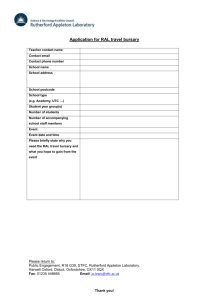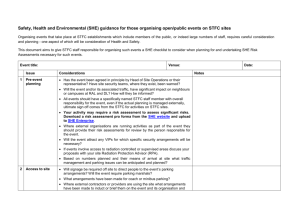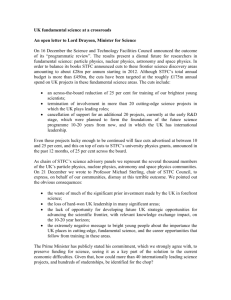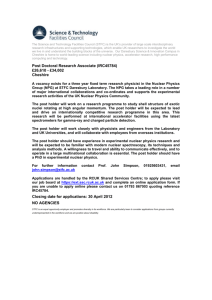Controlling Pollution to Air, Water or Land
advertisement
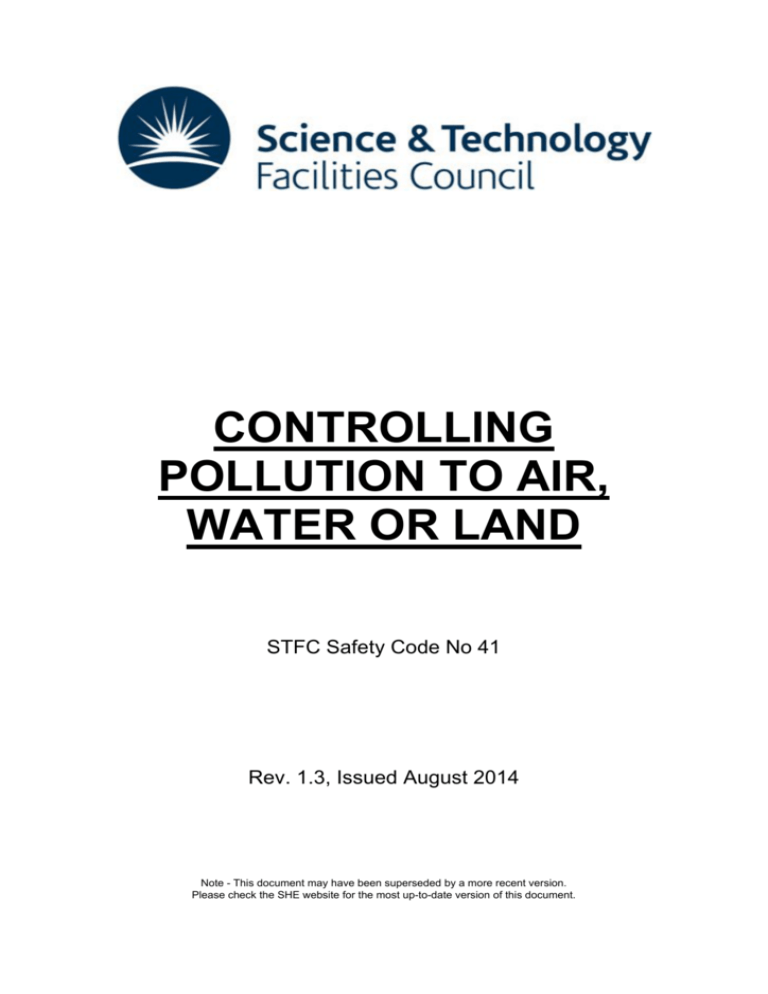
CONTROLLING POLLUTION TO AIR, WATER OR LAND STFC Safety Code No 41 Rev. 1.3, Issued August 2014 Note - This document may have been superseded by a more recent version. Please check the SHE website for the most up-to-date version of this document. Note - This document may have been superseded by a more recent version. Please check the SHE website for the most up-to-date version of this document. Revisions 1.0 1.1 1.2 1.3 Initial Issue Update to audit checklist Minor change to 4.2.1 and 4.2.7 Document Retention Policy Added Issue Number: 1.3 Issue Date: 14/08/2014 Author: Gareth Baker January 2012 May 2013 March 2014 August 2014 Page 2 of 19 Note - This document may have been superseded by a more recent version. Please check the SHE website for the most up-to-date version of this document. CONTENTS 1. PURPOSE ....................................................................................................................................... 4 2. SCOPE 3. DEFINITIONS .................................................................................................................................. 5 3.1. 3.2. 3.3. 3.4. 3.5. 3.6. 3.7. 3.8. 4. AUTHORISATION .............................................................................................................. 5 STATUTORY NUISANCE .................................................................................................... 5 TRADE W ASTE ................................................................................................................. 6 DOMESTIC (FOUL) W ASTE ................................................................................................ 6 SURFACE W ATER ............................................................................................................ 6 SENSITIVE ENVIRONMENTAL RECEPTOR ........................................................................... 6 HAZARDOUS W ASTE ........................................................................................................ 6 F-GAS............................................................................................................................. 6 RESPONSIBILITIES ....................................................................................................................... 7 4.1. 4.2. 4.3. 4.4. 5. ....................................................................................................................................... 5 HEADS OF ESTATES SHALL: .............................................................................................. 7 LINE MANAGERS AND CONTRACT SUPERVISING OFFICERS SHALL: ..................................... 7 STAFF AND OTHERS ENGAGED IN ACTIVITIES DISCHARGING TO AIR, LAND OR WATER SHALL: . 8 STFC ENVIRONMENT OFFICER SHALL: ............................................................................. 9 REFERENCES ................................................................................................................................ 9 APPENDIX 1. INFORMATION ON DISCHARGES TO AIR, WATER AND LAND ........................... 10 APPENDIX 2. ENVIRONMENTAL PERMIT EXEMPTIONS .............................................................. 13 APPENDIX 3. REGISTER OF LEGAL REQUIREMENTS AND ENVIRONMENTAL ASPECTS AND IMPACTS ASSESSMENTS (EAIS) ............................................................................ 14 APPENDIX 4. EXAMPLE F-GAS LOG SHEET ................................................................................. 15 APPENDIX 5. DRAIN MARKING COLOURS .................................................................................... 16 APPENDIX 6. TRAINING ................................................................................................................... 17 APPENDIX 7. AUDIT CHECKLIST .................................................................................................... 18 APPENDIX 8. DOCUMENT RETENTION POLICY ........................................................................... 19 Issue Number: 1.3 Issue Date: 14/08/2014 Author: Gareth Baker Page 3 of 19 Note - This document may have been superseded by a more recent version. Please check the SHE website for the most up-to-date version of this document. STFC Controlling Pollution to Air, Water or Land 1. Purpose The STFC Environment Policy commits the STFC to “ensuring high standards of environment management throughout our organisation … in accordance with local environmental standards and legislation”. This code establishes procedures to ensure that discharges to air, land or water comply with Environmental Permitting and other regulations: Environmental Permitting (England and Wales) Regulations 2010 Environmental Protection (Controls on Ozone Depleting Substances) Regulations 2011 Fluorinated Greenhouse Gases Regulations 2009 Water Industries Act 1991 Control of Pollution (Oil Storage)(England) Regulations 2001 And the Scottish counterparts of the above legislation. STFC sites require authorisation in the form of authorisations, permits or consents to carry out certain operations which may have detrimental effects on the environment. These include: Discharging certain hazardous substances to air above a threshold, for instance surface cleaning chemicals like trichloroethylene; Storing, treating or disposing of other peoples wastes (including that of its tenants); Discharging anything other than clean water to surface or groundwater, for instance neighbouring natural waterways, ponds or canals; Discharging trade waste to public sewers; Abstracting significant amounts of water from surface or groundwater; Transporting other peoples waste or arranging for someone else to do this (again including tenants); and Producing hazardous wastes. STFC activities that could potentially cause undue nuisance may also require a permit, for instance: Noise; Issue Number: 1.3 Issue Date: 14/08/2014 Author: Gareth Baker Page 4 of 19 Note - This document may have been superseded by a more recent version. Please check the SHE website for the most up-to-date version of this document. Odours; or Visual ‘pollution’, including light pollution. 2. Scope This code applies to all UK STFC owned and managed sites; this includes the Cockcroft Institute but not Swindon Office. This code applies to all STFC staff, visitors, tenants, contractors and facility users. This code applies to the release of gases, vapours and dusts to air; liquids to drains or land; the on-site processing or storage of solid wastes; and the creation of statutory nuisances. The code excludes radioactive wastes in any form (see SHE Code 21 Management of Radioactive Waste). The management of asbestos is covered by STFC SHE Code 32 Asbestos Management. 3. Definitions 3.1. Authorisation In this code the term Authorisation will be taken to mean either Consent to Discharge or Environmental Permit: 3.1.1. Consent to Discharge A Consent to Discharge is issued by a Utility company under the Water Industries Act. The document is required when non-domestic liquid waste is discharged to a public sewer (see Appendix 1). 3.1.2. Environmental Permit An Environmental Permit (or Exemption) is issued by the Environment Agency under the Environmental Permitting Regulations for discharges to land, air or controlled waters which may be hazardous to health or the environment (see Appendix 1), and for certain waste handling operations. 3.2. Statutory Nuisance Statutory nuisance is defined in section 79(10) of the Environmental Protection Act 1990: Smoke emitted from premises so as to be prejudicial to health or a nuisance; Any dust, steam, smell or any other effluvia arising on industrial, trade or business premises and being prejudicial to health or a nuisance; Any accumulation or deposit which is prejudicial to health or a nuisance; Artificial light emitted from a premises so as to be prejudicial to health or a nuisance; or Noise emitted from a premises so as to be prejudicial to health or a nuisance. Issue Number: 1.3 Issue Date: 14/08/2014 Author: Gareth Baker Page 5 of 19 Note - This document may have been superseded by a more recent version. Please check the SHE website for the most up-to-date version of this document. 3.3. Trade Waste Trade waste is any non-domestic liquid waste, other than surface water, resulting from industrial activity. This may be waste water contaminated with, for example: Chemicals; Suspended particulates; Oils and greases; or Detergents. 3.4. Domestic (Foul) Waste Domestic or foul waste is any waste from domestic sinks, showers or toilets. 3.5. Surface Water Surface water is any surface rainwater run-off, for example, from a roof, road, path or hard-standing. 3.6. Sensitive Environmental Receptor A Sensitive Environmental Receptor is an object or area that is at risk from harm as a result of emissions from a site. Examples would be a local canal, pond or aquifer. 3.7. Hazardous Waste Hazardous Wastes are wastes that are considered a hazard to human health or the environment, for example, if it is toxic to aquatic life (see STFC SHE Code 31, Controlled and Hazardous Waste). 3.8. F-Gas This is a generic term for Fluorinated Greenhouse Gases covered by the Kyoto Protocol. They include hydrofluorocarbons (HFCs - generic formula CnHmFx), perfluorocarbons (PFCs – generic formula CnFx) and sulphur hexafluoride (SF6). Within STFC they will typically be found in air conditioning systems, cooling systems, fire protection systems and solvent cleaning plants. Issue Number: 1.3 Issue Date: 14/08/2014 Author: Gareth Baker Page 6 of 19 Note - This document may have been superseded by a more recent version. Please check the SHE website for the most up-to-date version of this document. 4. Responsibilities 4.1. Heads of Estates shall: 4.1.1. Ensure that regular testing is carried out to ensure that each STFC site remains within any site authorisations. If indicated by the Environmental Impact Assessment (see Appendix 3) this may include proactive testing for land contamination. A list of current authorisations and their conditions can be viewed on the SHE website. 4.1.2. Ensure that site drainage is maintained, site drainage plans are kept up to date and that manhole covers are marked with the correct colour relating to its contents (see Appendix 5): Foul: red; Trade: yellow; Radioactive: yellow and black; and Surface water: blue. 4.1.3. Ensure that a site F-gas register is maintained (see Appendix 4) accounting for site F-gas inventories, and records of equipment installation and maintenance. 4.1.4. Maintain the estate so as to minimise ‘statutory nuisance’ (see 3.2). 4.2. Line Managers and Contract Supervising Officers shall: 4.2.1. For existing activities, and prior to commencing any new project or work activity, which may be expected to produce discharges, ensure that all possible discharges to air (including from fume cupboards), water (including foul drains) and land are assessed, and ‘statutory nuisance’ considered as part of the normal activity/project SHE risk assessments (see STFC Code 6, Risk Management and STFC Code 37, COSHH). Assessments should identify controls to reduce, as far as is reasonably practicable, any discharges, and minimise the environmental impact establishing operating procedures to control emissions, and contingency plans and equipment (for example ‘Spill kits’) to deal with any environmental incidents. 4.2.2. For existing activities, and prior to commencing any new project or work activity, such as emptying of effluent/neutralising pits or discharges from fume cupboards, ensure that they are within relevant Authorisations following consultation with the STFC Environment Officer, by establishing procedures to ensure compliance and using regular monitoring and testing of discharges. See Appendix 1. A list of current authorisations and their discharge conditions can be viewed on the SHE website. Issue Number: 1.3 Issue Date: 14/08/2014 Author: Gareth Baker Page 7 of 19 Note - This document may have been superseded by a more recent version. Please check the SHE website for the most up-to-date version of this document. 4.2.3. Ensure staff, visitors, facility users, tenants and contractors are aware of the requirements of any relevant site authorisations to control discharges to air, water or land or ‘statutory nuisance’ arising from the work they undertake. Where identified in the risk assessment, suitably equipped spill kits should be available and workers should be competent to deal with spills that arise. 4.2.4. Ensure that all environmentally sensitive liquids (for instance those with risk phrases R50-59) stored outside of buildings are bunded (held within secondary containment sufficient to hold 110% of the contents of the primary container, and where there is more than one storage container, the secondary containment must be capable of holding 110% of the largest container OR 25% of the total capacity of all containers, which ever is the greater) unless a documented SHE risk assessment permits the absence of a bund. All containers of more than 200 litres of oil (including fuel oil) must be held in secondary containment that will hold at least 110% of its capacity. The primary and secondary containment should be regularly inspected and maintained to ensure its integrity and records of such work retained. 4.2.5. Maintain equipment so as to ensure that it does not leak causing pollution to air, land or water, maintaining records of such work. 4.2.6. Report to STFC Estates all instances where F-Gases are employed, the initial inventory and any changes to that inventory and records of certified personnel employed to install and maintain such equipment, see Appendix 4. 4.2.7. Ensure that all leaks, spills and other unplanned discharges are contained and reported promptly in SHE enterprise (see STFC SHE Code 5, Incident Reporting and Investigation), where ‘Spill Kits’ have been established ensure that these are kept suitably stocked for the spills expected and as appropriate staff trained in their use, see Appendix 6. 4.3. Staff and others engaged in activities discharging to air, land or water shall: 4.3.1. As far as is reasonably practicable, endeavour to minimise the discharge of all liquid or gaseous wastes, in particular hazardous wastes, by prior consideration of the possible emissions that may arise from projects or work activities following the controls detailed in activity risk assessments. 4.3.2. Report all leaks, spills and other unplanned discharges promptly in SHE enterprise (see STFC SHE Code 5, Incident Reporting and Investigation). Issue Number: 1.3 Issue Date: 14/08/2014 Author: Gareth Baker Page 8 of 19 Note - This document may have been superseded by a more recent version. Please check the SHE website for the most up-to-date version of this document. 4.4. STFC Environment Officer shall: 4.4.1. Ensure that each STFC site has authorisations for any of its operations that require them and that this information is made available to staff via the SHE website. This will include details of any existing: Consents to discharge to foul drains (public sewers); Licences to produce hazardous wastes; Waste brokers licences where STFC is managing waste for site tenants; and Exemptions for certain waste operations. For example: chipping and composting of grounds maintenance waste and/or anaerobic digestion of food waste to produce compost; or baling of cardboard, see Appendix 2. 4.4.2. Ensure that any site emergency procedures, emergency exercises and associated training take account of locally sensitive environmental receptors (e.g. Bridgewater canal at DL and the Chilton Pond at RAL). 4.4.3. Ensure that sufficient spill kits, suitable for reasonably foreseeable site environmental incidents, are deployed, suitably located and regularly maintained for emergency use. 4.4.4. Maintain and review annually an environmental legal compliance register for all STFC sites, see Appendix 3. 4.4.5. Ensure that Environmental Aspects and Impacts assessments are conducted and maintained for all STFC sites, see Appendix 3. 4.4.6. Report any breaches of authorisations to the appropriate regulatory body in a timely manner. 5. References 5.1. General Permitting Guide (DEFRA) Issue Number: 1.3 Issue Date: 14/08/2014 Author: Gareth Baker Page 9 of 19 Note - This document may have been superseded by a more recent version. Please check the SHE website for the most up-to-date version of this document. Appendix 1. Information on Discharges to Air, Water and Land A1.1 Discharges to Air Generally speaking any significant intentional discharges to air of a hazardous substance in amounts of a tonne or more in any one year may require authorisation and SHE Group should be consulted prior to starting any such discharge. Discharges from fume cupboards within STFC are unlikely to require authorisation but nuisance from odours or smoke should be considered. However certain substances are covered by specific regulations: Solvent Emissions Directive/Regulations The purpose of the Solvent Emissions directive is to control emissions of volatile organic chemicals (VOCs) to the environment. It does not cover trivial emissions from, for instance, cleaning surfaces by wiping with a solvent soaked cloth, but may cover a large degreasing plant using tri-chloroethylene where the total emissions from the plant could be greater than 1 tonne per year. Where it might be envisaged that VOC usage on any particular installation could be of the order ‘tonnes per year’ then the SHE Group should be consulted to ensure that the installation complies with the Directive and that any authorisation and/or solvent management plan is in place and, as appropriate, the local authority informed. Note that the Control of Substances Hazardous to Health Regulations may also apply (see STFC SHE Code No 37) F-Gas & Ozone Depleting Substances A number of fluorinated solvents (chlorofluorocarbons – CFCs; hydrofluorocarbons – HFCs) and gases (especially SF6) are carefully controlled due to their effect on the ozone layer. The use of such chemicals for cleaning is banned and their use in selfcontained systems, such as refrigerant plant, is strictly controlled. Installations which use SF6, such as high voltage switchgear and certain refrigerant gases (e.g. R22), are subject to strict maintenance requirements and can only be maintained by qualified engineers. Such systems should be labelled and a log kept of all maintenance activities (see Appendix 4). It should also be noted that air-conditioning systems which have a total cooling capacity of greater than 12kWhr are required to comply with the Energy Performance of Buildings (Certificates and Inspections) Regulations. A1.2 Discharges to Controlled Waters Any intentional discharge, other than uncontaminated surface water, to a controlled water (for example a river or canal) will require an authorisation. Issue Number: 1.3 Issue Date: 14/08/2014 Author: Gareth Baker Page 10 of 19 Note - This document may have been superseded by a more recent version. Please check the SHE website for the most up-to-date version of this document. Abstraction of significant quantities of water from a controlled water course (and subsequent return), for example for cooling purposes, may also require authorisation. SHE Group should be consulted prior to any such proposed discharge or abstraction. A1.3 Discharges to foul (trade effluent) Discharge of waste water/liquid other than domestic sewage and uncontaminated rainwater will require authorisation. A1.4 Liquid Discharges from Laboratories It is permitted to dispose of certain chemicals which are not classified as ‘Hazardous Waste’ via a sink connected to a foul drain when washed down with excess water. These chemicals include: Mineral acids and alkalis which have been diluted to ensure the pH is between 6 and 10. Harmless soluble inorganic salts (including all drying agents such as CaCl2, MgSO4, Na2SO4, P2O5) Alcohols containing salts (e.g. from destroying sodium) Hypochlorite solutions from destroying cyanids, phosphines, etc. It is NOT permitted to dispose of chemicals on the UK ‘Red List’ via the drain; they are special waste and should be disposed of appropriately (See STFC SHE Code 31 for disposal procedure). If the above procedures cannot be guaranteed, then discharges from the laboratory should be to an effluent pit which can be tested for contamination before being batch pumped to foul or emptied as Special Waste, if contaminated. A1.5 Limits on Discharges of liquids Any authorisation to discharge liquids to either a controlled watercourse or to public sewer will specify limits on certain physical and chemical properties of the discharged liquid: pH; temperature; chemical oxygen demand; biological oxygen demand; suspended solids; heavy metal content; nitrate and sulphate content; and volume. A procedure must be put in place to ensure that any discharges are within the limits specified in the authorisation. Currently STFC sites hold the following authorisations: Issue Number: 1.3 Issue Date: 14/08/2014 Author: Gareth Baker Page 11 of 19 Note - This document may have been superseded by a more recent version. Please check the SHE website for the most up-to-date version of this document. DL – Trade RAL – Trade ROE – Trade A1.6 Discharges to Land The only discharges allowed to land within STFC are those of surface water. No other discharges to land are permitted. It is possible that historical spills to land have occurred and this should be considered when carrying out Environmental Impact Assessments (see Appendix 3), especially where there is an identifiable pathway to an environmentally sensitive receptor (such as a canal or underground aquifer). Issue Number: 1.3 Issue Date: 14/08/2014 Author: Gareth Baker Page 12 of 19 Note - This document may have been superseded by a more recent version. Please check the SHE website for the most up-to-date version of this document. Appendix 2. Environmental Permit Exemptions Generally speaking, any waste disposal or recovery operation requires an Environmental Permit under the Environmental Permitting Regulations. However certain operations that do not carry risk to the environment or human health are exempt from the full force of the regulations and are only required to be registered as ‘exempt waste operations’. These exemptions cover activities such as composting; baling or compacting waste prior to disposal; storage of certain waste prior to collection (e.g. batteries); and gardening operations such as chipping and mulching. STFC sites hold the following exemption certificates: DL Chipping and mulching RAL Composter; cardboard baler Coseners Cardboard baler Chilbolton (None) SO Composter ROE (None) Issue Number: 1.3 Issue Date: 14/08/2014 Author: Gareth Baker Page 13 of 19 Note - This document may have been superseded by a more recent version. Please check the SHE website for the most up-to-date version of this document. Appendix 3. Register of Legal Requirements and Environmental Aspects and Impacts Assessments (EAIs) Register of Legal Requirements Environmental best practice and any certified environmental management system requires that an organisation keeps a record of any environmental legislation which impacts on the organisation – a Register of Legal Requirements. This should contain details of the legislation; the requirements that the legislation places on the organisation; which activities are affected; the relevant regulatory body; and any related licenses, permits or consents. STFC maintains such a register on its SHE website. Environmental Aspects and Impacts Assessment (EIA). A further key part of any environmental management system is an assessment of the impact the organisation has on the environment. This is identified by careful analysis of those aspects of the organisation’s work which have an impact on the environment. Identifying the aspects which have a significant environmental impact and the controls established to minimise that impact, can indicate areas where environmental improvements can be made. The EIA should contain: A list of all potential environmental aspects The possible impacts of the aspects (both in normal operation and in maintenance or emergency situations). An assessment of the significance of the impact. A note of actions to be taken to reduce any significant impacts. Both the Register of Legal Requirements and the EIA should be regularly updated. Issue Number: 1.3 Issue Date: 14/08/2014 Author: Gareth Baker Page 14 of 19 Note - This document may have been superseded by a more recent version. Please check the SHE website for the most up-to-date version of this document. Appendix 4. EXAMPLE F-GAS LOG SHEET Taken from the DEFRA F Gas Regulations Guidance Document for Stationary Refrigeration, Air Conditioning and Heat Pump Users Issue Number: 1.3 Issue Date: 14/08/2014 Author: Gareth Baker Page 15 of 19 Note - This document may have been superseded by a more recent version. Please check the SHE website for the most up-to-date version of this document. Appendix 5. Drain Marking Colours Surface Water Drain Trade Waste Drain Foul Drain Radioactive Waste Drain Issue Number: 1.3 Issue Date: 14/08/2014 Author: Gareth Baker Page 16 of 19 Note - This document may have been superseded by a more recent version. Please check the SHE website for the most up-to-date version of this document. Appendix 6. Training Role Staff, facility users, tenants Estates staff Staff who may deploy spill kits Those servicing, maintaining or dismantling equipment containing ozone depleting substances Contractors Issue Number: 1.3 Training Refresher Frequency Comments Environmental management and waste disposal issues are included in site inductions, specific awareness campaigns and the launch presentation for this SHE code. 1 day Repeat 5 years Environmental Awareness Course Repeat 5 years ½ day Spill kit training City and Guilds certificate: Handling refrigerants, scheme 2078(a) Construction Industry Training Board: Safe handling of refrigerants reference 206710(b) Environmental management and waste disposal issues are included in site inductions Issue Date: 14/08/2014 Author: Gareth Baker Page 17 of 19 Note - This document may have been superseded by a more recent version. Please check the SHE website for the most up-to-date version of this document. Appendix 7. Audit Checklist Code Ref Question Officer Score Responsible 4.1.2 Are site drainage plans available and maintained? Head of Estates 4.1.2 Are drain covers marked with correct colour? Head of Estates 4.1.3 & 4.2.6 Is there an F-gas register and is it maintained Head of Estates 4.2.1 & 4.2.3 Is there evidence that possible discharges or statutory nuisances are considered in safety assessments? Line Managers 4.2.2 Is there evidence for testing of neutralising/settling pits? Line Managers 4.2.4 Where there are stores of fuel oil greater than 200l, are they suitably stored? Head of Estates & Line Managers 4.2.7 & 4.3.2 Is there evidence in SHE enterprise that leaks and spills are being reported? Line Managers and Staff 4.4.1 Are relevant global site authorisations in place? STFC Environment Officer 4.4.2 Evidence that testing of site emergency procedures includes environmental issues? STFC Environment Officer 4.4.3 Evidence of sufficient emergency spill kits on site STFC Environment Officer 4.4.4 Is the Legal Compliance register in place and maintained? STFC Environment Officer 4.4.5 & App 3 Are there Environmental Aspects and Impacts registers for STFC sites and are they maintained? STFC Environment Officer Issue Number: 1.3 Issue Date: 14/08/2014 Author: Gareth Baker Comments Page 18 of 19 Note - This document may have been superseded by a more recent version. Please check the SHE website for the most up-to-date version of this document. Appendix 8. Document Retention Policy Records established Minimum retention period Responsible location record of Comments/Justification keeper records Environmental Aspects and Current + 3 years SHE Group Impacts Register Land 50 Years from Contamination date of last entry Reports EA Permits/EA Permitting Exemptions All Current and Past F-Gas Register 5 Years from date of last entry Issue Number: 1.3 Local Record Systems Estates Teams Local Record System SHE Group Local Record System SHE Group Local Record System Issue Date: 14/08/2014 Author: Gareth Baker In the event of any query LA have power to insist we provide documentation but there is no legal requirement. Suggest 50 Years Collated from Departmental Records Page 19 of 19

